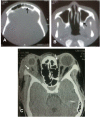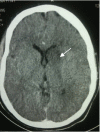Bilateral intraorbital abscesses with intracranial complications in a young Cameroonian girl: a case report
- PMID: 22969290
- PMCID: PMC3437950
- DOI: 10.2147/OPTH.S27034
Bilateral intraorbital abscesses with intracranial complications in a young Cameroonian girl: a case report
Abstract
Background: Intraorbital abscess is a very severe infection with ophthalmologic and neurologic complications that are sometimes life-threatening.
Objective: To report the etiologic, clinical, radiologic, and prognostic features of one case of bilateral intraorbital abscesses with intracranial complications.
Case report: A 15-year-old Cameroonian girl in a comatose state (11/15 on the Glasgow Coma Scale) with meningeal signs, right hemiplegia, right facial palsy, and bilateral exophthalmia was admitted for meningitis and cerebral abscess secondary to orbital cellulitis. A lumbar tap was carried out, no organisms were seen by Gram stain, and culture was negative due to previous antibiotic therapy. A computed tomography scan showed a left internal capsule infarct and a pansinus opacification. Bilateral superior orbitotomies were performed and the abscess evacuated. Microscopy and culture of surgical material were negative. The patient was discharged 4 weeks after hospital admission with a visual acuity of 0.1 in both eyes, aphasia, and right hemiplegia. Nine months later, there was complete visual recovery (visual acuity 1.0 in both eyes). Anterior and posterior segments were normal on slit-lamp examination. There was no aphasia, but right-sided hemiparesis persisted.
Conclusion: The authors emphasize the need for prevention, early diagnosis, and adequate treatment of orbital cellulitis in order to avoid complications.
Keywords: hemiparesis; intracranial complications; intraorbital abscess; orbital cellulitis; orbitotomies; pansinusitis.
Figures



Similar articles
-
Bilateral cellulitis caused by invasive aspergillosis associated with bilateral intraorbital abscesses: a case report.BMC Ophthalmol. 2020 Aug 15;20(1):330. doi: 10.1186/s12886-020-01606-7. BMC Ophthalmol. 2020. PMID: 32799822 Free PMC article.
-
Bilateral cavernous sinus thromboses and intraorbital abscesses secondary to Streptococcus milleri.Ophthalmology. 2003 Mar;110(3):569-74. doi: 10.1016/S0161-6420(02)01765-7. Ophthalmology. 2003. PMID: 12623823
-
Outcome of treated orbital cellulitis in a tertiary eye care center in the middle East.Ophthalmology. 2007 Feb;114(2):345-54. doi: 10.1016/j.ophtha.2006.07.059. Ophthalmology. 2007. PMID: 17270683
-
Orbital cellulitis, orbital subperiosteal and intraorbital abscess: report of three cases and review of the literature.J Craniomaxillofac Surg. 2009 Apr;37(3):132-6. doi: 10.1016/j.jcms.2008.10.007. Epub 2008 Dec 4. J Craniomaxillofac Surg. 2009. PMID: 19062300 Review.
-
Multiple brain abscesses caused by Salmonella typhi: case report.Surg Neurol. 2000 Jan;53(1):86-90. doi: 10.1016/s0090-3019(99)00161-5. Surg Neurol. 2000. PMID: 10697239 Review.
Cited by
-
Delayed intraorbital infection after craniofacial bone surgery.Arch Craniofac Surg. 2019 Oct;20(5):324-328. doi: 10.7181/acfs.2019.00360. Epub 2019 Oct 20. Arch Craniofac Surg. 2019. PMID: 31658798 Free PMC article.
References
-
- Ailal F, Bousfiha A, Jouhadi Z, Bennani M, Abid A. Orbital cellulitis in children: a retrospective study of 33. Med Trop (Mars) 2004;64(4):359–362. French. - PubMed
-
- Suneetha N, Battu RR, Thomas RK, Bosco A. Orbital abscess: management and outcome. Indian J Ophthalmol. 2000;48(2):129–134. - PubMed
-
- Chandler JR, Langenbrunner DJ, Stevens ER. The pathogenesis of orbital complications in acute sinusitis. Laryngoscope. 1970;80(9):1414–1428. - PubMed
-
- Mortimore S, Wormald PJ. The Groote Schuur Hospital classification of the orbital complications of sinusitis. J Laryngol Otol. 1997;111(8):719–723. - PubMed
-
- Watkins LM, Pasternack MS, Banks M, Kousoubris P, Rubin PA. Bilateral cavernous sinus thromboses and intraorbital abscesses secondary to Streptococcus milleri. Ophthalmology. 2003;110(3):569–574. - PubMed
Publication types
LinkOut - more resources
Full Text Sources
Miscellaneous

